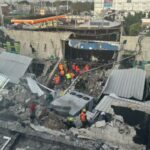Seismic Sequence from January 26 to February 7: Over 11,700 Earthquakes
Experts continue monitoring the seismic activity in Santorini. Geological Oceanography Professor Evi Law reports that a research team on the island “will perform GNSS satellite observations at about 20 trigonometric points in North Santorini, Thirassia, and North Kammenos.” These measurements aim to “combine them with data from permanent GNSS stations to ensure the safest detection of microtremors in the Earth’s solid crust in the area.”
Additionally, at least 50 gravity stations will be measured across the above islands to map the area’s gravitational field and detect changes over time.
Conclusions on Subsurface Changes
“The combination of these measurements will provide conclusions about changes in the subsurface of the area, as well as changes in the mass or density of the rocks in the measurement region,” Professor Law notes in a post on her personal Facebook page.
Finally, she announced that “a photogrammetric scan using thermal cameras with BSEA will be conducted in areas identified by the NCSR to detect or confirm the region’s thermal fields.”
“In an Active Volcano, You Need a Lot of Data”
In her statements, Professor Law emphasized the importance of repeated gravity measurements, which were first taken in 2011 and 2012 at the same points during the volcanic crisis in the Santorini Caldera.
When asked if measurements would be taken elsewhere, Professor Nomikou responded that 50 points had already been measured, with about 100 more to go. The collected gravity data will be combined with marine gravity data obtained from the oceanographic mission of 2015 to update the gravity map of the entire Santorini volcanic complex.
The Army Geographical Service (GIS), in collaboration with the NCSR’s Natural Geography Laboratory and the Dionysus Satellite Center of NTUA, continues to contribute to the monitoring of seismic activity in the wider Santorini area.








